Upcoming events
Grand Assumption Procession
August 15, 2006, 5:30 p.m.
Metropolitan Cathedral of San Fernando
Join us as we revive one of San Fernando's biggest pre-war traditions, the grand procession on the feastday of Our Lady of the Assumption. Relive the good old "pistaym" days as we don our best Filipiniana attires. See you there!
Manyaman Pamangan Kapampangan
August 27, 2006 (Sunday), 9 a.m. to 5 p.m.
Santuario de San Antonio, Forbes Park, Makati City
Invite your family and friends to this one-day Kapampangan food festival. Enjoy home-made ensaimada, pako shrimp salad, San Nicolas cookies, panara, tamales and other delicacies you grew up with. Mangan tamu qng Forbes!
A Taste of Pampanga
August 14 to 25, 2006
Captain's Bar, Mandarin Oriental Manila
Experience the awesome cuisine of Pampanga, also known as the culinary center of the Philippines, as Captain's Bar brings you some of the province's flavourful and exotic fare. Join the reunion of Kapampangan old families during the opening on Monday, August 14 at 11:30 a.m. For reservations and enquiries, call 750 8888 extension 2417 / 2418.
50th Anniversary Celebrations of the
Canonical Coronation of the Virgen de los Remedios
September 8, 2006
Villa del Sol, City of San Fernando, Pampanga
Malacanang declared this day a non-working holiday in the Province of Pampanga. Join in the celebrations as we commemorate the feast of the patroness of Pampanga.
Pyestang Tugak 2006: 4th Annual San Fernando Frog Festival
October 11 to 12, 2006
Poblacion and Greenville Subdivision, San Jose, City of San Fernando, Pampanga
The province of Pampanga is known for its frog traditions and cuisine. These traditions are however fast disappearing due to inevitable progress and urban growth, hence the need to rekindle and promote these traditions.
On day 1, there will be a street dance competition and parade. While day 2 will host the traditional and fun events including the padwasan (frog-catching contest) early in the morning, frog olympics and dress-up your frog contest, and the frog cooking contests. This festival is close to my heart since I was the one who started it in 2003 when I was still tourism officer of San Fernando. So I invite everyone to take part.
Anyway, to those asking about what to see and do in Pampanga, check out the tourism MTV produced by the Pampanga Provincial Government...
Also check out the videos at Indung Kapampangan.
Friday, August 11, 2006
Tuesday, August 08, 2006
Zamboanga: Santa Cruz Island and its pink sand
And now, for the final installment of my recent trip is my visit to the Great and Little Santa Cruz Island Protected Landscapes and Seascapes. I had booked my trip with the DOT regional office. I could have opted to go on my own but that would mean paying for the entire boat. So I kept my fingers crossed hoping that a group would leave Sunday, and that they would allow me to tag along. Good thing there was a group of local teachers and students who booked a trip while I was in the office.
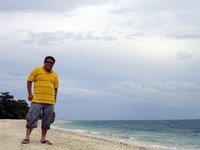 So I was up early to make sure I made the 7 a.m. call time. There was still no sign of the group at 7:15 a.m. so that got me worried. Until finally someone had approached me asking if I was the one who was going to tag along. It turned out, the group had two designated meeting places. And the bigger group which was at the pier was gone before the organizer had arrived. To make things worse, there were just three of us at Lantaka Hotel, myself, the organizer and a student.
So I was up early to make sure I made the 7 a.m. call time. There was still no sign of the group at 7:15 a.m. so that got me worried. Until finally someone had approached me asking if I was the one who was going to tag along. It turned out, the group had two designated meeting places. And the bigger group which was at the pier was gone before the organizer had arrived. To make things worse, there were just three of us at Lantaka Hotel, myself, the organizer and a student.
 After waiting for sometime, we decided to check again at the pier. We would later find out when we got to the island that the group which met at the pier, after seeing the rough waves which were a result of the tail end of "Inday," had backed out! Anyway, after some haggling with the boat owner, we were able to bring down the cost thanks to our appeal to pity.
After waiting for sometime, we decided to check again at the pier. We would later find out when we got to the island that the group which met at the pier, after seeing the rough waves which were a result of the tail end of "Inday," had backed out! Anyway, after some haggling with the boat owner, we were able to bring down the cost thanks to our appeal to pity.
So the three of us made the trip to Santa Cruz despite the rough seas. And I was tense for the most part as our boat made the slow trip to the island, rocked by strong waves. I was actually praying for sunshine. We got there in one piece. And for some twist of fate, the sun did come out a few minutes after we arrived on Great Santa Cruz Island.
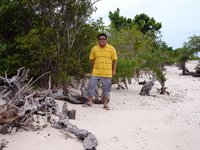 The two islands which are a few meters away from each other, and the waters that surround it form the Great and Little Santa Cruz Island Protected Landscapes and Seascapes. Both islands often play host to environmental activities with students from local universities such as Ateneo de Zamboanga organizing tree-planting activities and coastal clean-ups. There are just about forty families which live on the island, all from the Samal tribe which was allowed to stay in the protected area.
The two islands which are a few meters away from each other, and the waters that surround it form the Great and Little Santa Cruz Island Protected Landscapes and Seascapes. Both islands often play host to environmental activities with students from local universities such as Ateneo de Zamboanga organizing tree-planting activities and coastal clean-ups. There are just about forty families which live on the island, all from the Samal tribe which was allowed to stay in the protected area.
What makes the sand on the island unique is its distinct pink color which is a result of tiny pink coral fragments mixed with the white sand. For a close up of the sand, click here. And just like in Malamawi White Beach, I had the beach all to myself! We learned from the locals there that even before Puerto Galera and Boracay, Santa Cruz was a popular destination among tourists. But after the spate of abductions and kidnappings many years back, its popularity waned.
 Anyway, after a brief dip in the blue water, I decided to walk around the island. It would take two hours to walk around from end to end. So I just hiked a few meters to check out the other side. As you can see from an aerial photo which I took from the plane, the center of the island was mostly mangrove swamps and a lagoon.
Anyway, after a brief dip in the blue water, I decided to walk around the island. It would take two hours to walk around from end to end. So I just hiked a few meters to check out the other side. As you can see from an aerial photo which I took from the plane, the center of the island was mostly mangrove swamps and a lagoon.
We went back to downtown Zamboanga at about 12 noon and this time, the water was calmer. But I had a worse headache than the day before. Again, I decided to eat at Tini's where I ordered murtabak daging (beef prata) and roti kosong (flour pancake). Then I walked back to the pension house to freshen up and take a quick nap. I made sure not to sleep too long since I wanted to visit as much as I could during my last 24 hours in Zamboanga City.
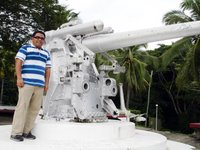 Next on my itinerary was a trip to Mt. Pulong Bato in Barangay Abong Abong from where visitors are rewarded with a breathtaking view of Zamboanga City and the outlying islands. From downtown, I took a jeep to Abong Abong via Pasonanca which was just PHP10. Make sure you mention to the driver that you want to visit the stations of the cross so that he could drop you off at the foot of the mountain. I was dropped off at a place called canyon or Freedom Park which had some military relics, large guns in particular hence the moniker canyon, and a tomb for an unknown soldier.
Next on my itinerary was a trip to Mt. Pulong Bato in Barangay Abong Abong from where visitors are rewarded with a breathtaking view of Zamboanga City and the outlying islands. From downtown, I took a jeep to Abong Abong via Pasonanca which was just PHP10. Make sure you mention to the driver that you want to visit the stations of the cross so that he could drop you off at the foot of the mountain. I was dropped off at a place called canyon or Freedom Park which had some military relics, large guns in particular hence the moniker canyon, and a tomb for an unknown soldier.
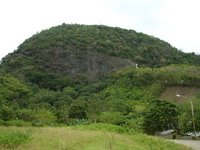 I thus ended up walking an extra 1.5 kilometers to the foot of the mountain, not including the 750 meter steep climb to the vantage point. On the way up were bas relief murals of the fourteen stations of the cross. That was really exhausting! But the view from on top was worth the climb. Since the road is well paved, you can drive a vehicle up as well.
I thus ended up walking an extra 1.5 kilometers to the foot of the mountain, not including the 750 meter steep climb to the vantage point. On the way up were bas relief murals of the fourteen stations of the cross. That was really exhausting! But the view from on top was worth the climb. Since the road is well paved, you can drive a vehicle up as well.
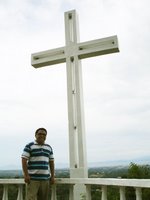 It was about 3:30 p.m. and I had to rush down and back to downtown since I had one more destination on my itinerary, the oldest mosque in Zamboanga in Barangay Taluksangay. People had warned me that it was going to be far but that did not hinder me. So as soon as I got back to downtown, I immediately boarded a jeep to the Muslim community of Taluksangay near the Mercedes District. It was about 17 kilometers away and the fare was PHP20.
It was about 3:30 p.m. and I had to rush down and back to downtown since I had one more destination on my itinerary, the oldest mosque in Zamboanga in Barangay Taluksangay. People had warned me that it was going to be far but that did not hinder me. So as soon as I got back to downtown, I immediately boarded a jeep to the Muslim community of Taluksangay near the Mercedes District. It was about 17 kilometers away and the fare was PHP20.
I arrived there at 5 p.m. just before the sun went down. I was happy to see a marker of the National Historical Institute which emphasized the significance of the site to our nation's history.
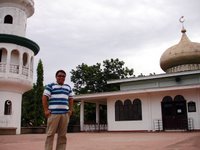 As I mentioned earlier, this was the first mosque in the Zamboanga Peninsula. Built by Hadji Abdullah Maas Nuno in 1885, it was the first center of Islam which was recognized by the international Islamic community.
As I mentioned earlier, this was the first mosque in the Zamboanga Peninsula. Built by Hadji Abdullah Maas Nuno in 1885, it was the first center of Islam which was recognized by the international Islamic community.
Anyway, going back to downtown Zamboanga City was going to be a problem since the jeepney driver had mentioned me that there were no more trips back. So from Taluksangay, I took a pedicab to the next barangay which was Talabaan where motorcycles-for-hire were waiting to take me back to the highway. The trip was PHP30 and I agreed since I would be able to stopover at the Gabaldon buildings in the Mercedes Central School. I was surprised to see many of the buildings intact. Aside from the main building, the original home economics and industrial arts buildings were still standing.
From the highway, I took a jeep back to downtown. The good thing about the public transport system in Zamboanga City is that all jeepneys travel to the downtown area so you can easily find you way around. I got off at St. Joseph's Church to hear Mass. The church was air-conditioned which was a welcome feeling after a humid and tiring day.
 After Mass, my plan was to check out those satti outlets again. It was just 7 p.m. and I was surprised to see all of them closed! So I asked a tricycle driver to take me to the nearest sattihan. The driver mentioned to me that those were the only ones he knew. And that the reason they closed early was because they were open as early as 4 a.m. So that's why! It turns out satti was a breakfast dish in Zamboanga.
After Mass, my plan was to check out those satti outlets again. It was just 7 p.m. and I was surprised to see all of them closed! So I asked a tricycle driver to take me to the nearest sattihan. The driver mentioned to me that those were the only ones he knew. And that the reason they closed early was because they were open as early as 4 a.m. So that's why! It turns out satti was a breakfast dish in Zamboanga.
Anyway, I went back to Tini's for dinner since this was the last chance I could eat roti in a long time. And I made sure I went to bed early since my plan was to savor the elusive satti before I left on the 9:55 a.m. flight. I was up at 6 a.m. and finally, I was able to treat myself to satti! As I mentioned in a previous post, these were three small pieces of roasted beef on a barbeque stick dipped in a bowl of sweet and spicy sauce served with rice floating in another plate of the same sauce. Each was PHP3.50 and the rice was something like PHP8 per serving (if you remember the rice I had in Larsian which I mentioned in my Cebu entry, it was the same one).
I then went back to the pension house to take a quick nap. After checking out, I took a tricycle to the airport for PHP30. I was quite early for the flight but it was better to be there early than to be left behind. Good thing there was a massage service there so I got myself relaxed before boarding.
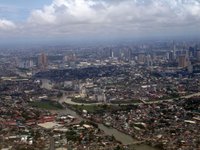 One thing I liked about the experience at the airport was that everyone on the runway, from the ground crew to the security guards waved at the plane as it left the tarmac. It was a very heartwarming experience for passengers looking out the windows.
One thing I liked about the experience at the airport was that everyone on the runway, from the ground crew to the security guards waved at the plane as it left the tarmac. It was a very heartwarming experience for passengers looking out the windows.
I took a lot of photos on the plane as well. Here are two of them. The first is the Ortigas area with the Pasig River and the old Rizal Provincial Capitol in the green open space along the river close to the center of the photo. The bridge you see is the C5 Bridge.
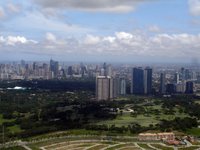 The second photo is Makati with the Fort Bonifacio Global City and American Cemetery in the foreground. I guess that's it for now. Until the next trip.
The second photo is Makati with the Fort Bonifacio Global City and American Cemetery in the foreground. I guess that's it for now. Until the next trip.
 So I was up early to make sure I made the 7 a.m. call time. There was still no sign of the group at 7:15 a.m. so that got me worried. Until finally someone had approached me asking if I was the one who was going to tag along. It turned out, the group had two designated meeting places. And the bigger group which was at the pier was gone before the organizer had arrived. To make things worse, there were just three of us at Lantaka Hotel, myself, the organizer and a student.
So I was up early to make sure I made the 7 a.m. call time. There was still no sign of the group at 7:15 a.m. so that got me worried. Until finally someone had approached me asking if I was the one who was going to tag along. It turned out, the group had two designated meeting places. And the bigger group which was at the pier was gone before the organizer had arrived. To make things worse, there were just three of us at Lantaka Hotel, myself, the organizer and a student. After waiting for sometime, we decided to check again at the pier. We would later find out when we got to the island that the group which met at the pier, after seeing the rough waves which were a result of the tail end of "Inday," had backed out! Anyway, after some haggling with the boat owner, we were able to bring down the cost thanks to our appeal to pity.
After waiting for sometime, we decided to check again at the pier. We would later find out when we got to the island that the group which met at the pier, after seeing the rough waves which were a result of the tail end of "Inday," had backed out! Anyway, after some haggling with the boat owner, we were able to bring down the cost thanks to our appeal to pity.So the three of us made the trip to Santa Cruz despite the rough seas. And I was tense for the most part as our boat made the slow trip to the island, rocked by strong waves. I was actually praying for sunshine. We got there in one piece. And for some twist of fate, the sun did come out a few minutes after we arrived on Great Santa Cruz Island.
 The two islands which are a few meters away from each other, and the waters that surround it form the Great and Little Santa Cruz Island Protected Landscapes and Seascapes. Both islands often play host to environmental activities with students from local universities such as Ateneo de Zamboanga organizing tree-planting activities and coastal clean-ups. There are just about forty families which live on the island, all from the Samal tribe which was allowed to stay in the protected area.
The two islands which are a few meters away from each other, and the waters that surround it form the Great and Little Santa Cruz Island Protected Landscapes and Seascapes. Both islands often play host to environmental activities with students from local universities such as Ateneo de Zamboanga organizing tree-planting activities and coastal clean-ups. There are just about forty families which live on the island, all from the Samal tribe which was allowed to stay in the protected area.What makes the sand on the island unique is its distinct pink color which is a result of tiny pink coral fragments mixed with the white sand. For a close up of the sand, click here. And just like in Malamawi White Beach, I had the beach all to myself! We learned from the locals there that even before Puerto Galera and Boracay, Santa Cruz was a popular destination among tourists. But after the spate of abductions and kidnappings many years back, its popularity waned.
 Anyway, after a brief dip in the blue water, I decided to walk around the island. It would take two hours to walk around from end to end. So I just hiked a few meters to check out the other side. As you can see from an aerial photo which I took from the plane, the center of the island was mostly mangrove swamps and a lagoon.
Anyway, after a brief dip in the blue water, I decided to walk around the island. It would take two hours to walk around from end to end. So I just hiked a few meters to check out the other side. As you can see from an aerial photo which I took from the plane, the center of the island was mostly mangrove swamps and a lagoon.We went back to downtown Zamboanga at about 12 noon and this time, the water was calmer. But I had a worse headache than the day before. Again, I decided to eat at Tini's where I ordered murtabak daging (beef prata) and roti kosong (flour pancake). Then I walked back to the pension house to freshen up and take a quick nap. I made sure not to sleep too long since I wanted to visit as much as I could during my last 24 hours in Zamboanga City.
 Next on my itinerary was a trip to Mt. Pulong Bato in Barangay Abong Abong from where visitors are rewarded with a breathtaking view of Zamboanga City and the outlying islands. From downtown, I took a jeep to Abong Abong via Pasonanca which was just PHP10. Make sure you mention to the driver that you want to visit the stations of the cross so that he could drop you off at the foot of the mountain. I was dropped off at a place called canyon or Freedom Park which had some military relics, large guns in particular hence the moniker canyon, and a tomb for an unknown soldier.
Next on my itinerary was a trip to Mt. Pulong Bato in Barangay Abong Abong from where visitors are rewarded with a breathtaking view of Zamboanga City and the outlying islands. From downtown, I took a jeep to Abong Abong via Pasonanca which was just PHP10. Make sure you mention to the driver that you want to visit the stations of the cross so that he could drop you off at the foot of the mountain. I was dropped off at a place called canyon or Freedom Park which had some military relics, large guns in particular hence the moniker canyon, and a tomb for an unknown soldier. I thus ended up walking an extra 1.5 kilometers to the foot of the mountain, not including the 750 meter steep climb to the vantage point. On the way up were bas relief murals of the fourteen stations of the cross. That was really exhausting! But the view from on top was worth the climb. Since the road is well paved, you can drive a vehicle up as well.
I thus ended up walking an extra 1.5 kilometers to the foot of the mountain, not including the 750 meter steep climb to the vantage point. On the way up were bas relief murals of the fourteen stations of the cross. That was really exhausting! But the view from on top was worth the climb. Since the road is well paved, you can drive a vehicle up as well. It was about 3:30 p.m. and I had to rush down and back to downtown since I had one more destination on my itinerary, the oldest mosque in Zamboanga in Barangay Taluksangay. People had warned me that it was going to be far but that did not hinder me. So as soon as I got back to downtown, I immediately boarded a jeep to the Muslim community of Taluksangay near the Mercedes District. It was about 17 kilometers away and the fare was PHP20.
It was about 3:30 p.m. and I had to rush down and back to downtown since I had one more destination on my itinerary, the oldest mosque in Zamboanga in Barangay Taluksangay. People had warned me that it was going to be far but that did not hinder me. So as soon as I got back to downtown, I immediately boarded a jeep to the Muslim community of Taluksangay near the Mercedes District. It was about 17 kilometers away and the fare was PHP20.I arrived there at 5 p.m. just before the sun went down. I was happy to see a marker of the National Historical Institute which emphasized the significance of the site to our nation's history.
 As I mentioned earlier, this was the first mosque in the Zamboanga Peninsula. Built by Hadji Abdullah Maas Nuno in 1885, it was the first center of Islam which was recognized by the international Islamic community.
As I mentioned earlier, this was the first mosque in the Zamboanga Peninsula. Built by Hadji Abdullah Maas Nuno in 1885, it was the first center of Islam which was recognized by the international Islamic community.Anyway, going back to downtown Zamboanga City was going to be a problem since the jeepney driver had mentioned me that there were no more trips back. So from Taluksangay, I took a pedicab to the next barangay which was Talabaan where motorcycles-for-hire were waiting to take me back to the highway. The trip was PHP30 and I agreed since I would be able to stopover at the Gabaldon buildings in the Mercedes Central School. I was surprised to see many of the buildings intact. Aside from the main building, the original home economics and industrial arts buildings were still standing.
From the highway, I took a jeep back to downtown. The good thing about the public transport system in Zamboanga City is that all jeepneys travel to the downtown area so you can easily find you way around. I got off at St. Joseph's Church to hear Mass. The church was air-conditioned which was a welcome feeling after a humid and tiring day.
 After Mass, my plan was to check out those satti outlets again. It was just 7 p.m. and I was surprised to see all of them closed! So I asked a tricycle driver to take me to the nearest sattihan. The driver mentioned to me that those were the only ones he knew. And that the reason they closed early was because they were open as early as 4 a.m. So that's why! It turns out satti was a breakfast dish in Zamboanga.
After Mass, my plan was to check out those satti outlets again. It was just 7 p.m. and I was surprised to see all of them closed! So I asked a tricycle driver to take me to the nearest sattihan. The driver mentioned to me that those were the only ones he knew. And that the reason they closed early was because they were open as early as 4 a.m. So that's why! It turns out satti was a breakfast dish in Zamboanga.Anyway, I went back to Tini's for dinner since this was the last chance I could eat roti in a long time. And I made sure I went to bed early since my plan was to savor the elusive satti before I left on the 9:55 a.m. flight. I was up at 6 a.m. and finally, I was able to treat myself to satti! As I mentioned in a previous post, these were three small pieces of roasted beef on a barbeque stick dipped in a bowl of sweet and spicy sauce served with rice floating in another plate of the same sauce. Each was PHP3.50 and the rice was something like PHP8 per serving (if you remember the rice I had in Larsian which I mentioned in my Cebu entry, it was the same one).
I then went back to the pension house to take a quick nap. After checking out, I took a tricycle to the airport for PHP30. I was quite early for the flight but it was better to be there early than to be left behind. Good thing there was a massage service there so I got myself relaxed before boarding.
 One thing I liked about the experience at the airport was that everyone on the runway, from the ground crew to the security guards waved at the plane as it left the tarmac. It was a very heartwarming experience for passengers looking out the windows.
One thing I liked about the experience at the airport was that everyone on the runway, from the ground crew to the security guards waved at the plane as it left the tarmac. It was a very heartwarming experience for passengers looking out the windows.I took a lot of photos on the plane as well. Here are two of them. The first is the Ortigas area with the Pasig River and the old Rizal Provincial Capitol in the green open space along the river close to the center of the photo. The bridge you see is the C5 Bridge.
 The second photo is Makati with the Fort Bonifacio Global City and American Cemetery in the foreground. I guess that's it for now. Until the next trip.
The second photo is Makati with the Fort Bonifacio Global City and American Cemetery in the foreground. I guess that's it for now. Until the next trip.
Saturday, August 05, 2006
Basilan: Off the beaten track in Basilan
Today, I visited Basilan. Just the mere mention of the name evokes fear among those unfamiliar with the place. Every time I told someone that I was on my way to Basilan, I received a shocked response. Who would want to visit Basilan anyway? But if not for the bad publicity brought by the Abu Sayaff many years back, Basilan would be a perfect ecotourism destination if developed properly.
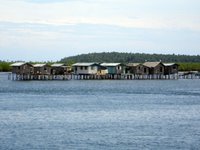 I was planning to get up early today but that didn't work. I was still unusually tired. Anyway, instead of the early morning fast craft to Isabela City in Basilan, I was able to catch the 9:30 a.m. The fare for a first class ticket was PHP130. The ordinary seats at PHP100, although also air-conditioned, are usually jampacked. So the extra PHP30 was worth it. I arrived in Basilan about an hour later.
I was planning to get up early today but that didn't work. I was still unusually tired. Anyway, instead of the early morning fast craft to Isabela City in Basilan, I was able to catch the 9:30 a.m. The fare for a first class ticket was PHP130. The ordinary seats at PHP100, although also air-conditioned, are usually jampacked. So the extra PHP30 was worth it. I arrived in Basilan about an hour later.
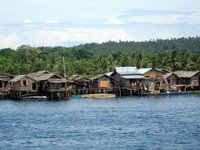 Greeting you as you entered the port were villages on stilts and the minarets of mosques at the center of these communities. From the port, I took a short walk up to the provincial capitol where I decided to take a tricycle to the passenger terminal to Lamitan. My first stop for the day was a waterfalls in the heart of a town made infamous by the sensational clashes between the military and the Abu Sayaff a while back. And here I was on my way there for a visit!
Greeting you as you entered the port were villages on stilts and the minarets of mosques at the center of these communities. From the port, I took a short walk up to the provincial capitol where I decided to take a tricycle to the passenger terminal to Lamitan. My first stop for the day was a waterfalls in the heart of a town made infamous by the sensational clashes between the military and the Abu Sayaff a while back. And here I was on my way there for a visit!
I took a commuter van to Lamitan which was about 27 kilometers away from Isabela. The trip costed PHP40. I was expecting to see bad roads after all that fighting years back but I was impressed since the roads to Lamitan were very well-paved, not a sign of the hostilities that ensued in the past.
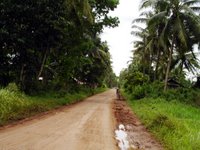 As soon as I arrived in Lamitan, I asked around on how to could get to Bulingan Falls. I was pointed to a motorcycle-for-hire who agreed to take me there for PHP100. It was fair enough since the falls were quite far. I would figure it was a 10-kilometer trip from the town proper to the falls, which was bumpy most of the way and quite muddy at times. The trip took me deeper into Lamitan town which I'm sure used to be evacuated often before when hostilities between the Abu Sayaff and the military were ongoing.
As soon as I arrived in Lamitan, I asked around on how to could get to Bulingan Falls. I was pointed to a motorcycle-for-hire who agreed to take me there for PHP100. It was fair enough since the falls were quite far. I would figure it was a 10-kilometer trip from the town proper to the falls, which was bumpy most of the way and quite muddy at times. The trip took me deeper into Lamitan town which I'm sure used to be evacuated often before when hostilities between the Abu Sayaff and the military were ongoing.
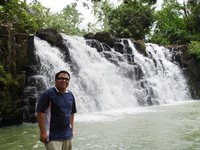 You could still feel the turbulent past of the area since we passed by several military check points and camps along the way. One thing which surprised me was that the barangays going to the falls were predominantly Catholic since each had a little chapel. I didn't see a mosque either. It seems most of them could be found in the coastal areas.
You could still feel the turbulent past of the area since we passed by several military check points and camps along the way. One thing which surprised me was that the barangays going to the falls were predominantly Catholic since each had a little chapel. I didn't see a mosque either. It seems most of them could be found in the coastal areas.
Bulingan Falls was not tall at all. But what made it nice were the square shaped rocks from which the water cascaded down to the pool below. You could see that the falls was frequented by tourists since the mayor had the banks cemented and built several picnic huts on the side. They could have done a better job though.
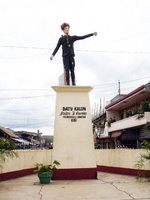 It was then back down that dirt road to the town proper. Lamitan town has been turned into another of those nondescript Philippine communities. And the only distinguishing landmark in the center of town is the statue of its founder Datu Kalun.
It was then back down that dirt road to the town proper. Lamitan town has been turned into another of those nondescript Philippine communities. And the only distinguishing landmark in the center of town is the statue of its founder Datu Kalun.
From Lamitan, I took a commuter van back to Isabela City. It was about 1 p.m. and after lunch, I decided to take a walk back to the pier. My plan was to take the last ferry back at 5:30 p.m. but since the weather was unpredictable, it would drizzle then the sun would come out, I decided to take the 3:30 p.m. trip back to Zamboanga.
Since I had time to spare, I asked about Malamawi Beach. It turns out, Malamawi is the island just across the port. And the beach on one side of the island was known to locals as White Beach obviously because of the white sand. There are frequent commuter pump boats which take passengers across the strait for PHP5. So since I had a lot of time, I decided to check it out.
The trip across was just about 5 minutes. At the opposite end, motorcycles-for-hire were waiting to take you to any point on the island. I was charged PHP20 one-way which was not bad. Again, it was off the beaten track since once you left Barangay Carbon proper, there were no roads, just motorcycle trails.
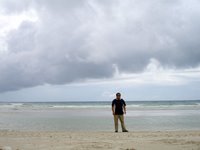 It was quite a distance and the trip took you to the other side of the island, passing by small communities living in vast mangrove forests. Among the obstacles we had to avoid were the occasional cows grazing amongst the thick vegetation along the path.
It was quite a distance and the trip took you to the other side of the island, passing by small communities living in vast mangrove forests. Among the obstacles we had to avoid were the occasional cows grazing amongst the thick vegetation along the path.
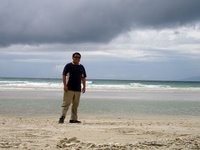 We finally arrived at the beach. And I wished I had brought my swimming gear! When visiting Malamawi White Beach, it's best that you go with a group and take a pump boat straight to the place. If you're alone, you'll have to make arrangements with the motorcycle to come back for you at a later time.
We finally arrived at the beach. And I wished I had brought my swimming gear! When visiting Malamawi White Beach, it's best that you go with a group and take a pump boat straight to the place. If you're alone, you'll have to make arrangements with the motorcycle to come back for you at a later time.
There were a lot of run down beach huts and picnic tables all over the place; but just a small group of tourists enjoying the white sand. Sometimes you'd realize there are so many underrated beaches all over the country worth visiting, little pieces of paradise secretly tucked away for those diligent enough to search for them and enjoy the serenity they offer.
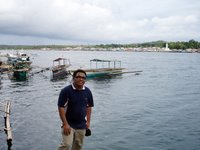 After a few photos, it was back to Barangay Carbon, and then back to the port of Isabela just across. Again, I purchased a first class ticket which was a passport to comfort since I did not have to join the rat race into the fast craft since only a few people buy the said tickets.
After a few photos, it was back to Barangay Carbon, and then back to the port of Isabela just across. Again, I purchased a first class ticket which was a passport to comfort since I did not have to join the rat race into the fast craft since only a few people buy the said tickets.
By the time we neared Zamboanga, I was already very dizzy. It was an ordeal walking back to the pension house. But I decided to take a quick snack at Tini's where I bought my favorite roti telor and roti kosong (flour pancakes accompanied with curry dip). When I got back to the pension house, the next thing I knew was I was asleep again. I made sure I got enough rest since I had to be up early to catch the boat to Santa Cruz Island the next day.
 I was planning to get up early today but that didn't work. I was still unusually tired. Anyway, instead of the early morning fast craft to Isabela City in Basilan, I was able to catch the 9:30 a.m. The fare for a first class ticket was PHP130. The ordinary seats at PHP100, although also air-conditioned, are usually jampacked. So the extra PHP30 was worth it. I arrived in Basilan about an hour later.
I was planning to get up early today but that didn't work. I was still unusually tired. Anyway, instead of the early morning fast craft to Isabela City in Basilan, I was able to catch the 9:30 a.m. The fare for a first class ticket was PHP130. The ordinary seats at PHP100, although also air-conditioned, are usually jampacked. So the extra PHP30 was worth it. I arrived in Basilan about an hour later. Greeting you as you entered the port were villages on stilts and the minarets of mosques at the center of these communities. From the port, I took a short walk up to the provincial capitol where I decided to take a tricycle to the passenger terminal to Lamitan. My first stop for the day was a waterfalls in the heart of a town made infamous by the sensational clashes between the military and the Abu Sayaff a while back. And here I was on my way there for a visit!
Greeting you as you entered the port were villages on stilts and the minarets of mosques at the center of these communities. From the port, I took a short walk up to the provincial capitol where I decided to take a tricycle to the passenger terminal to Lamitan. My first stop for the day was a waterfalls in the heart of a town made infamous by the sensational clashes between the military and the Abu Sayaff a while back. And here I was on my way there for a visit!I took a commuter van to Lamitan which was about 27 kilometers away from Isabela. The trip costed PHP40. I was expecting to see bad roads after all that fighting years back but I was impressed since the roads to Lamitan were very well-paved, not a sign of the hostilities that ensued in the past.
 As soon as I arrived in Lamitan, I asked around on how to could get to Bulingan Falls. I was pointed to a motorcycle-for-hire who agreed to take me there for PHP100. It was fair enough since the falls were quite far. I would figure it was a 10-kilometer trip from the town proper to the falls, which was bumpy most of the way and quite muddy at times. The trip took me deeper into Lamitan town which I'm sure used to be evacuated often before when hostilities between the Abu Sayaff and the military were ongoing.
As soon as I arrived in Lamitan, I asked around on how to could get to Bulingan Falls. I was pointed to a motorcycle-for-hire who agreed to take me there for PHP100. It was fair enough since the falls were quite far. I would figure it was a 10-kilometer trip from the town proper to the falls, which was bumpy most of the way and quite muddy at times. The trip took me deeper into Lamitan town which I'm sure used to be evacuated often before when hostilities between the Abu Sayaff and the military were ongoing. You could still feel the turbulent past of the area since we passed by several military check points and camps along the way. One thing which surprised me was that the barangays going to the falls were predominantly Catholic since each had a little chapel. I didn't see a mosque either. It seems most of them could be found in the coastal areas.
You could still feel the turbulent past of the area since we passed by several military check points and camps along the way. One thing which surprised me was that the barangays going to the falls were predominantly Catholic since each had a little chapel. I didn't see a mosque either. It seems most of them could be found in the coastal areas.Bulingan Falls was not tall at all. But what made it nice were the square shaped rocks from which the water cascaded down to the pool below. You could see that the falls was frequented by tourists since the mayor had the banks cemented and built several picnic huts on the side. They could have done a better job though.
 It was then back down that dirt road to the town proper. Lamitan town has been turned into another of those nondescript Philippine communities. And the only distinguishing landmark in the center of town is the statue of its founder Datu Kalun.
It was then back down that dirt road to the town proper. Lamitan town has been turned into another of those nondescript Philippine communities. And the only distinguishing landmark in the center of town is the statue of its founder Datu Kalun.From Lamitan, I took a commuter van back to Isabela City. It was about 1 p.m. and after lunch, I decided to take a walk back to the pier. My plan was to take the last ferry back at 5:30 p.m. but since the weather was unpredictable, it would drizzle then the sun would come out, I decided to take the 3:30 p.m. trip back to Zamboanga.
Since I had time to spare, I asked about Malamawi Beach. It turns out, Malamawi is the island just across the port. And the beach on one side of the island was known to locals as White Beach obviously because of the white sand. There are frequent commuter pump boats which take passengers across the strait for PHP5. So since I had a lot of time, I decided to check it out.
The trip across was just about 5 minutes. At the opposite end, motorcycles-for-hire were waiting to take you to any point on the island. I was charged PHP20 one-way which was not bad. Again, it was off the beaten track since once you left Barangay Carbon proper, there were no roads, just motorcycle trails.
 It was quite a distance and the trip took you to the other side of the island, passing by small communities living in vast mangrove forests. Among the obstacles we had to avoid were the occasional cows grazing amongst the thick vegetation along the path.
It was quite a distance and the trip took you to the other side of the island, passing by small communities living in vast mangrove forests. Among the obstacles we had to avoid were the occasional cows grazing amongst the thick vegetation along the path. We finally arrived at the beach. And I wished I had brought my swimming gear! When visiting Malamawi White Beach, it's best that you go with a group and take a pump boat straight to the place. If you're alone, you'll have to make arrangements with the motorcycle to come back for you at a later time.
We finally arrived at the beach. And I wished I had brought my swimming gear! When visiting Malamawi White Beach, it's best that you go with a group and take a pump boat straight to the place. If you're alone, you'll have to make arrangements with the motorcycle to come back for you at a later time.There were a lot of run down beach huts and picnic tables all over the place; but just a small group of tourists enjoying the white sand. Sometimes you'd realize there are so many underrated beaches all over the country worth visiting, little pieces of paradise secretly tucked away for those diligent enough to search for them and enjoy the serenity they offer.
 After a few photos, it was back to Barangay Carbon, and then back to the port of Isabela just across. Again, I purchased a first class ticket which was a passport to comfort since I did not have to join the rat race into the fast craft since only a few people buy the said tickets.
After a few photos, it was back to Barangay Carbon, and then back to the port of Isabela just across. Again, I purchased a first class ticket which was a passport to comfort since I did not have to join the rat race into the fast craft since only a few people buy the said tickets.By the time we neared Zamboanga, I was already very dizzy. It was an ordeal walking back to the pension house. But I decided to take a quick snack at Tini's where I bought my favorite roti telor and roti kosong (flour pancakes accompanied with curry dip). When I got back to the pension house, the next thing I knew was I was asleep again. I made sure I got enough rest since I had to be up early to catch the boat to Santa Cruz Island the next day.
Friday, August 04, 2006
Zamboanga: Hola Zamboanga!
 Those are the words which greet passengers as they arrive at the Zamboanga International Airport. A visit to Zamboanga City is like visiting our nation's past where our Spanish colonizers seem to have left the strongest imprint of their 300-year rule. Chabacano, the creole language spoken in the area, is said to contain 60 percent Spanish and 40 percent nativo words.
Those are the words which greet passengers as they arrive at the Zamboanga International Airport. A visit to Zamboanga City is like visiting our nation's past where our Spanish colonizers seem to have left the strongest imprint of their 300-year rule. Chabacano, the creole language spoken in the area, is said to contain 60 percent Spanish and 40 percent nativo words.Anyway, I hardly remembered the flight I took from Manila at 4:55 a.m. since I was fast asleep, tired from the work this week. I was so sleepy in fact that I wanted to go straight to bed. But I decided to take photos first of the City Hall of Zamboanga for the 2007 HCS calendar while there were no vehicles parked in front.
 So from the airport, I took a jeep to Canellar Street which was a few meters away from city hall. Most of the old historic core of Zamboanga City was relatively intact. It's one of the few cities I've visited which had maintained its character. Beside the city hall were several colonial structures and newer structures which followed the colonial theme. Yes, the Jolibee store in front of Rizal Park was a new building which chose to adapt its facade to the buildings beside it. I would have been all praises for it if not for the exageration of tarpaulin streamers on its windows and facade.
So from the airport, I took a jeep to Canellar Street which was a few meters away from city hall. Most of the old historic core of Zamboanga City was relatively intact. It's one of the few cities I've visited which had maintained its character. Beside the city hall were several colonial structures and newer structures which followed the colonial theme. Yes, the Jolibee store in front of Rizal Park was a new building which chose to adapt its facade to the buildings beside it. I would have been all praises for it if not for the exageration of tarpaulin streamers on its windows and facade. A few meters away was another open space called Plaza Pershing (that's what Metro cities lack, green open spaces). I was surprised to see the original lamposts intact but in a bad state of deterioration. Sad to say the buildings around it do not complement such a charming plaza.
A few meters away was another open space called Plaza Pershing (that's what Metro cities lack, green open spaces). I was surprised to see the original lamposts intact but in a bad state of deterioration. Sad to say the buildings around it do not complement such a charming plaza.From city hall, I took a walk towards Fort Pilar, a national cultural treasure. Along the way were more old structures along a royal palm tree-lined street. And you could see the great adaptive re-use such as the Bank of the Philippine Islands branch office in a restored old house. I commend BPI because even the signage is subtle and does not distract the viewer from the intricate woodwork of the house's facade. If only the city government pushes this a little further.
 After some photos at the fort, I decided to walk back and try to look for a place to stay. I was quite tired and sleepy so I did my usual backpackers routine which was walk until I find an affordable place to stay in. I found a pension house very close to Plaza Pershing and got an air-conditioned room for PHP440 a night.
After some photos at the fort, I decided to walk back and try to look for a place to stay. I was quite tired and sleepy so I did my usual backpackers routine which was walk until I find an affordable place to stay in. I found a pension house very close to Plaza Pershing and got an air-conditioned room for PHP440 a night.It was quite unlike me but I didn't do much today, went to bed for the most part. In the afternoon, I went back to Fort Pilar since it was still closed earlier. I also dropped by the DOT regional office beside Lantaka Hotel to ask some questions and book myself a trip to Santa Cruz Island which I will describe in detail in the next entries.
 Then is was time for a snack. Lo and behold, my favorite Indian food was sold in Zamboanga in a restaurant called Tini's Malaysian-Bruneian Restaurant just a few meters from city hall. So I ordered a murtabak ayam (chicken murtabak) and iced Milo.
Then is was time for a snack. Lo and behold, my favorite Indian food was sold in Zamboanga in a restaurant called Tini's Malaysian-Bruneian Restaurant just a few meters from city hall. So I ordered a murtabak ayam (chicken murtabak) and iced Milo.After another nap, it was time for dinner and to sample a Zamboanga dish called satti which is sold along Pilar Street. I was surprised though when I woke up that it was raining really hard. So it was flooded when I got to Pilar Street. None of the satti outlets were open but I found a canteen which served it but it wasn't as good as the freshly grilled ones. Satti may have gotten its name from a similar Malay dish called satay. But satti is smaller is serving size, three tiny pieces of roasted beef on a barbeque stick. It is served to you in a bowl of sweet and spicy sauce with rice chunks also swimming in a pool of the same sauce. Anyway, I'll show you photos of it in a later entry.
Sunday, July 30, 2006
Manila: The walled city of Intramuros before the war
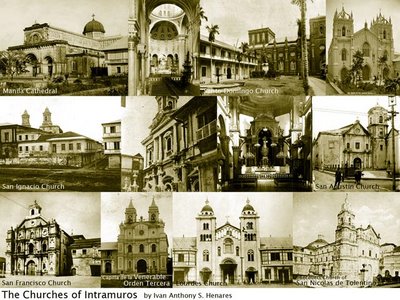 We have been trying influence many of the local government leaders and the clergy to adopt heritage conservation practices to preserve the character of our own cities and towns. But add to the fact that so much was already lost during the Second World War which is why we have to be more aggressive in protecting what's left.
We have been trying influence many of the local government leaders and the clergy to adopt heritage conservation practices to preserve the character of our own cities and towns. But add to the fact that so much was already lost during the Second World War which is why we have to be more aggressive in protecting what's left.To illustrate my point, I will hark back at the good old pistaym days when Manila was in its heyday. In Intramuros today, there are only two churches left, namely the Manila Cathedral and San Agustin Church. In fact, the Manila Cathedral that is standing today is a reconstruction of the original one and only San Agustin was unscathed during the war.
Before the war, there were at least nine of these grandiose and gargantuan churches within meters away from each other. These included the Manila Cathedral, Santo Domingo Church with the original main building of the University of Santo Tomas beside it, the Jesuit Church of San Ignacio beside the Ateneo de Manila (it was said that "there was so much wood in the church that it took all of four days for the conflagration to consume the buffet of tropical hardwoods – narra, tindalo, magcono, molave – cut from the mountain fastness of Surigao and transported to Manila seven decades previous), San Agustin Church, the Franciscan Churches of San Francisco and the Venerable Orden Tercera which were right beside each other sharing the same plaza, the Capuchin Church of Lourdes, the Augustinian Recollect Church of San Nicolas de Tolentino and the San Jose Church.
And those were just churches. I did not even touch on smaller chapels, colleges and universities, religious institutions and government buildings. Oh yes! We had ostentatious and elegant palace-like government buildings in Manila! And that was just Intramuros. The districts outside the walls such as Binondo, Santa Cruz, Ermita, Malate and San Miguel where equally charming as well.
Indeed, Manila was as beautiful as any European city. But we lost everything, centuries of work, in just a matter of days during the liberation of Manila. Sadly, unlike Europe which was also devastated mind you, we did not rebuild many of these monuments to Filipino craftsmanship and excellence. And all we could do now is sigh and say "Sayang!"
Subscribe to:
Posts (Atom)
